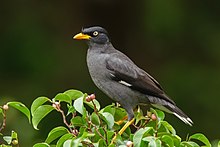| Javan myna | |
|---|---|

| |
| Conservation status | |
 Vulnerable (IUCN 3.1) | |
| Scientific classification | |
| Domain: | Eukaryota |
| Kingdom: | Animalia |
| Phylum: | Chordata |
| Class: | Aves |
| Order: | Passeriformes |
| Family: | Sturnidae |
| Genus: | Acridotheres |
| Species: | A. javanicus |
| Binomial name | |
| Acridotheres javanicus Cabanis, 1851 | |
The Javan myna (Acridotheres javanicus), also known as the white-vented myna, is a species of myna. It is a member of the starling family. It is native to Bali and Java. It has been introduced to other Asian countries, and as far away as Puerto Rico.
Taxonomy
The Javan myna is sometimes included in the great myna (Acridotheres grandis) or the jungle myna (A. fuscus). The International Ornithologists' Union recommends not using the name "white-vented myna" to avoid confusion with the Pale-bellied Myna A. cinereus.
Description

The Javan myna is mainly black. The wings are brownish-black, and the primaries have white bases, displayed in flight as a striking white wing bar, along with a white tail bar. The undertail-coverts are white. There is a short crest on the forehead. Its beak, legs and feet are yellow. The eyes are lemon-yellow. The immature is browner. Its length is 21–23 cm (8.3–9.1 in). Its weight is about 100 g (3.5 oz).
Habitat
The Javan myna is native to Bali and Java, and has been introduced to southeastern Thailand, southern Malaysia, Singapore, Sumatra, the Lesser Sundas, Taiwan, Puerto Rico, Japan and Nepal. It is found in cities and cultivated areas.
Behaviour
Javan mynas are bold and not very afraid of humans. Javan mynas are kept in cages in Malaysia and Indonesia.
Diet
The Javan myna is omnivorous and eats seeds, fruit, nectar, insects and human waste.
In Pairs
Javan mynas are found in pairs and associate in larger groups. Its voice is similar to that of the common myna. It builds its nest in holes. The eggs are bluish-glaucous.
The birds scavenge in groups, minimum two but usually three or more, with all except one feeding and one usually at a vantage point keeping a look out. If the bird that is keeping watch sees anything that might pose a threat, it alarms the group members with a high pitch tweet and they all flee the area swiftly. If one of them is separated, they would tend to tweet to attract other mynas of their kind to come over.
Juveniles
The juvenile, or fledgling, period of a Javan myna lasts about 25 days. Juveniles tend to be browner, with a very short brown frontal crest. Juvenile Javan mynas will no longer be fed in the nest and will learn to beg for food from its parents. This is to teach the juvenile to feed itself. When begging, juveniles stand at the same spot every now and then with its wings hanging down, fluttering lightly occasionally beside its body. All juveniles need to be taught by the adults on how to forage for food, to avoid potential predators before they can live independent lives.
Eggs
The eggs of a Javan myna are blue in colour and takes 13-14 days to hatch.
References
- BirdLife International (2020). "Acridotheres javanicus". IUCN Red List of Threatened Species. 2020: e.T103871334A176499647. doi:10.2305/IUCN.UK.2020-3.RLTS.T103871334A176499647.en. Retrieved 20 November 2021.
- Tasirin, Johny S.; Fitzsimons, James A. (2014). "Javan (White-vented) Myna Acridotheres javanicus and Pale-bellied Myna A. cinereus in North Sulawesi". Kukila. 18 (1): 27–31. hdl:10536/DRO/DU:30072161.
- ^ Craig, Adrian; Feare, Chris (2010). Starlings and Mynas. A&C Black. pp. 151–152. ISBN 9781408135228.
- ^ "White-vented Myna (Acridotheres javanicus)". Handbook of the Birds of the World Alive. Retrieved 4 October 2016.
- "How long does the recently fledged juvenile Javan Myna remains with the adults? - Bird Ecology Study Group". besgroup.org. 2017-11-09. Retrieved 2025-01-10.
- "taxo4254 - Acridotheres javanicus". singapore.biodiversity.online. Retrieved 2025-01-10.
- ^ "An eggshell from above… a nesting nearby - Bird Ecology Study Group". besgroup.org. 2017-12-01. Retrieved 2025-01-10.
- "Begging behaviour of a newly fledged Javan Myna - Bird Ecology Study Group". besgroup.org. 2018-12-27. Retrieved 2025-01-10.
This Sturnidae-related article is a stub. You can help Misplaced Pages by expanding it. |